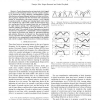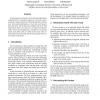782 search results - page 90 / 157 » 3D Human Walking Modeling |
TOG
2008
13 years 7 months ago
2008
Modeling the large space of possible human motions requires scalable techniques. Generalizing from example motions or example controllers is one way to provide the required scalab...
IJCAI
2007
13 years 9 months ago
2007
Programming a humanoid robot to walk is a challenging problem in robotics. Traditional approaches rely heavily on prior knowledge of the robot's physical parameters to devise...
BC
2004
13 years 7 months ago
2004
As humans increase walking speed, there are concurrent transitions in the frequency ratio between arm and leg movements from 2:1 to 1:1 and in the phase relationship between the mo...
ICRA
2007
IEEE
14 years 2 months ago
2007
IEEE
— Passive dynamics plays an important role in legged locomotion of the biological systems. The use of passive dynamics is expected for energy efficiency, self-stabilization agai...
ISWC
1999
IEEE
14 years 3 days ago
1999
IEEE
By integrating visual media with positioning information obtained with our wearable computer, we create new opportunities for using visuals both in the field and at the workstatio...


